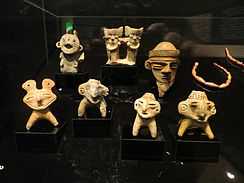Lake Guatavita
| Laguna de Guatavita | |
|---|---|
 | |
| Location | Sesquilé, Cundinamarca |
| Coordinates | 4°58′38″N 73°46′32″W / 4.97722°N 73.77556°WCoordinates: 4°58′38″N 73°46′32″W / 4.97722°N 73.77556°W |
| Primary inflows | rain |
| Basin countries | Colombia |
| Surface elevation | c. 3,000 m |


Laguna de Guatavita is located in the municipality of Sesquilé, in the Almeidas Province, Cundinamarca department of Colombia, 35 miles north-east of Bogotá, capital of the Republic of Colombia.
It is an Andean crater lake formed in a cinder cone after the volcanic vent below it became inactive and cooled down. There are Hot Springs nearby giving the name of the nearby Municipality of Sesquilé, which means hot water.
Myths and Legends
Laguna de Guatavita was reputedly one of the sacred lakes of the Muisca, and a ritual conducted there is widely thought to be the basis for the legend of El Dorado. The legend says the lake is where the Muisca celebrated a ritual in which the Zipa (named "El Dorado" by the Conquistadores) was covered in gold dust, then venturing out into the water on a ceremonial raft made of rushes, he dived into the waters, washing off the gold. Afterward, trinkets, jewelry, and other precious offerings were thrown into the waters by worshipers. A few artifacts of gold and silver found at bottom hold proof to this claim; however, to date, the trips to the bottom of the lake have yielded no more than these (see below).
Another one of the Pre-Columbian myths concerning Lake Guatavita is of a local tribal Cacique (chief) and the serpent god believed to live in the waters. After discovering that one of his wives had been unfaithful to him, the chief ordered her lover's murder and then his wife was forced to eat the dead man's sexual organs. He also paid musicians to compose and sing songs about her infidelity around the town.
His wife then fled from home with her baby daughter, and flung herself and the child into the lake. Upon hearing the news of this, the chief sorrowfully regretted his actions, and begged for help from the local shaman, asking him to find a way of bringing her and the baby back.
The shaman made a sacrifice to the serpent god of the lake and hurled heated stones into the waters, after which he dived in and swam to the deep.
The shaman discovered the chief's wife and daughter living on the bed of the lake with the serpent god. He hurried back to the surface to report this to the chief, who then ordered him to go back to bring his wife and child home.
After many hours, the shaman returned, bringing with him only the corpse of the child. On battling the serpent god for the wife and child of the chief, the serpent god had devoured the child's eyes and the baby had died. The wife meanwhile remained at the bottom of the lake with the serpent god.
Historical attempts to recover the gold
Conquistadores Lázaro Fonte and Hernán Perez de Quesada attempted (unsuccessfully) to drain the lake in 1545 using a "bucket chain" of labourers. After 3 months, the water level had been reduced by 3 metres, and only a small amount of gold was recovered, with a value of 3000–4000 pesos (approx. 100,000 USD today; a peso or piece of eight of the 15th century weighs .88oz of 93% pure silver).
A later more industrious attempt was made in 1580, by Bogotá business entrepreneur Antonio de Sepúlveda. A notch was cut deep into the rim of the lake, which managed to reduce the water level by 20 metres, before collapsing and killing many of the labourers. A share of the findings—consisting of various golden ornaments, jewellery and armour—was sent to King Philip the 2nd of Spain. Sepúlveda's discovery came to approximately 12,000 pesos. He died a poor man, and is buried at the church in the small town of Guatavita.
In 1801, Alexander von Humboldt made a visit to Guatavita, and on his return to Paris, calculated from the findings of Sepúlveda's efforts that Guatavita could offer up as much as $300 million worth of gold.
In 1898, 'The Company for the Exploitation of the Lagoon of Guatavita' was formed and taken over by 'Contractors Ltd.' of London, in a deal brokered by British expatriate Mr Hartley Knowles. The lake was drained by a tunnel that emerged in the centre of the lake. The water was drained to a depth of about 4 feet of mud and slime.[2]
This made it impossible to explore, and when the mud had dried sitting and being baked by the sun, it had set like concrete. A haul of only £500 was found, and auctioned at Sothebys of London. Some of these artifacts were donated to the British Museum.[3] The company filed for bankruptcy and ceased activities in 1929.Trivia
Lake Guatavita is where Fanny Lú filmed her music video for her song No Te Pido Flores.
References
- ↑ http://books.google.com/books?id=qgcvcj2v1ZwC&pg=PA40&dq=king+muisca+gold+dust&hl=en&sa=X&ei=VOrmUabcJLK14AOApYHYDQ&ved=0CC0Q6AEwAA#v=onepage&q=king%20muisca%20gold%20dust&f=false
- ↑ http://books.google.com/books?id=TRAU0cS3410C&pg=PA113&lpg=PA113&dq=contractors+limited+guatavita&source=bl&ots=nzG7maZCB_&sig=dTquY6B_q-8Q5BYBTlRwgHShqu8&hl=en&sa=X&ei=KufmUarsD5bd4AOe8IFw&ved=0CDEQ6AEwBA
- ↑ British Museum Collection
External links
- The Legend of 'El Dorado' by Tairona Heritage Trust